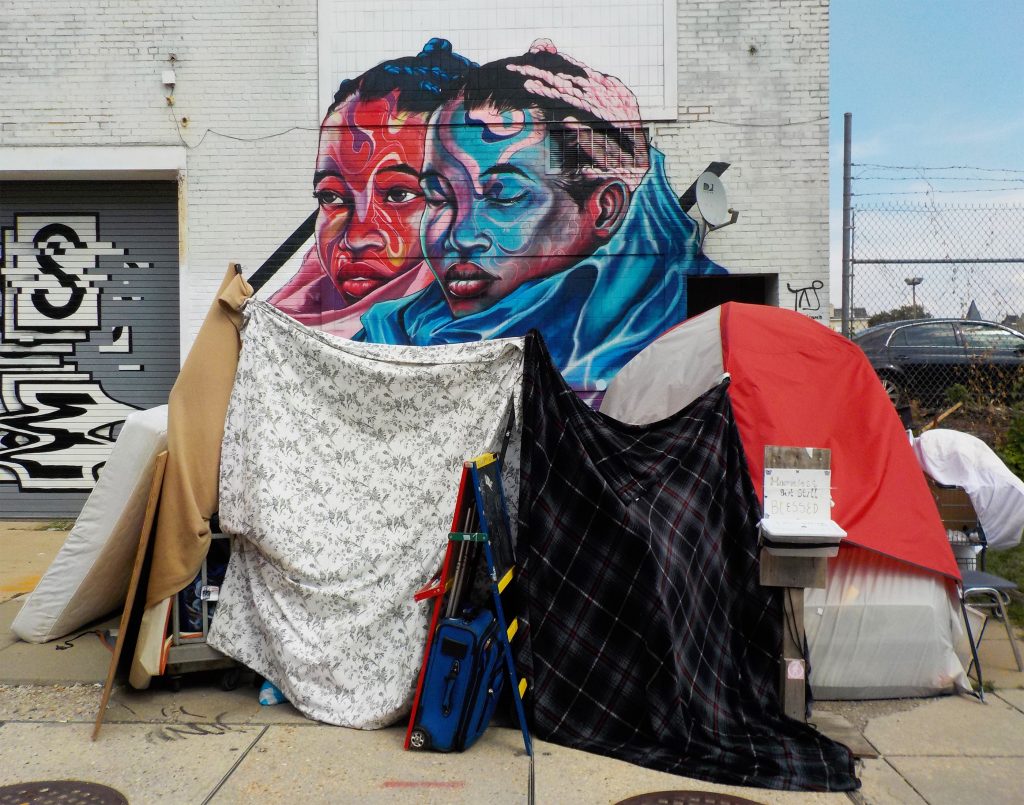
The goal of this project is to shift the narrative on how we view homelessness and build a path to solve this solvable problem.
NEW YORK — With more than half a million people in the United States experiencing homelessness, Law@theMargins on Dec. 11 launched “The Right to a Home,” a collaborative journalism series that explores how communities across America are addressing this national problem at the local level to create viable, long-term solutions.
Supported by a Solutions Journalism Network grant and led by Community Based News Room (CBNR), “The Right to a Home” was produced in partnership with four street media papers: Street Spirit in Berkeley, California; StreetWise in Chicago; The Contributor in Nashville, Tennessee; and Street Sense Media in Washington, D.C. We provided on-the-ground reporting with homeless community members and professional journalists to produce eight stories on issues impacting the homeless community in America.
“We are excited to showcase our ‘Right to a Home’ series with street newspapers, which have a long tradition of providing a space for those unhoused to tell their stories with dignity,” said Chaumtoli Huq, Law@theMargins founder and Community Based News Room (CBNR) publisher. “Our unique collaborative journalism model helps people with lived experiences of injustice report on solutions. We don’t tell their stories, but provide the structure and support so that they can report on the issues that impact them directly.”
CBNR’s collaborative journalism approach develops trust between the reporter and community, elevates public discourse on homelessness and leads to more meaningful community actions and outcomes.
“It is a powerful form of journalism that can shift the narrative on how we view homelessness,” said Eric Ortiz, executive editor of Community Based News Room and a 20-year veteran journalist. “Homelessness has reached critical levels. Our project stands up for the rights and well-being of the less fortunate and is important and urgent work. CBNR will continue to support the homeless community. Through rigorous reporting about how people are responding to homeless issues, we can help balance the news on the subject, strengthen engagement, and build trust that has eroded between the housed and unhoused community.”
Sixteen people worked on our project to present a new perspective on homelessness and inspire real-world change.
“I found the collaboration with other journalists to be exciting,” said Vicky Batcher, a street reporter for The Contributor in Nashville, who was homeless for seven years and co-wrote one of the stories in our series on the decriminalization of the homeless. “Working on articles about the challenges facing the homeless was not only a learning experience, but one of dedication in educating the public.”
“We are excited to have had the chance to do some in-depth reporting on an issue important to our readers, to shed light on important work done in the community and to have gained fresh journalistic skills,” said Suzanne Hanney, the editor of StreetWise in Chicago, who worked on stories about ending food insecurity through local food ecosystems and veteran homelessness.
“This is a great opportunity to showcase the various perspectives on ending homelessness,” said Reginald Black, a veteran street reporter for Street Sense, who has experienced unsheltered homelessness and wrote about the need for the homeless community to be involved in policymaking for homeless services. “I hope these kinds of collaborations continue until we have solved this solvable problem.’
“Those who are scurrying past the tents on city streets may not give it much thought, especially when it comes to the homeless, but empowering people to shape their own lives is important for a thriving democracy,” said Joseph Young, a veteran journalist who worked with Street Sense reporters to investigate the homeless encampment issue and need for supportive housing in Washington, D.C.
“Solutions-based journalism has the power to change the course of the world we live in, and ‘The Right to a Home’ series has potential to do just that by addressing societal challenges surrounding homelessness, such as food insecurity and inadequate housing, and sharing creative solutions from around the country to try to eradicate these issues,” said Alexandria Jacobson, a journalist based in Chicago, who worked with StreetWise and reported how food justice is necessary for social justice.
“Publishing the words of unhoused people is just the first step,” said Ariel Boone, a journalist based in Berkeley, who reported on community-driven solutions to provide affordable housing for all. “Next, our leaders have to take them seriously when they say they’re offering a corrective to the current system — and build the public will to change everything.”
“As with all community news, we’re stronger and more effective when we work collaboratively,” said Eric Falquero, Street Sense editor. “My hope is that more people learn about the 40-plus news outlets and economic empowerment programs like the four of us in cities across the U.S., and new readers see what may work to prevent and end homelessness in their community. And having been challenged to grow in our use of solutions journalism will inform our work well beyond this project.”
In 2020, as part of “The Right to a Home” series, we will have a public webinar and four events on homelessness in each of the four street media partner cities. Dates and times will be announced.
Law@theMargins is a law and media nonprofit organization committed to lifting up the perspectives of individuals and communities whose voices are not often included in mainstream media and discourse.
Inspired by community journalists like Ida B. Wells-Barnett, our Community Based News Room (CBNR) started in April 2018 and works with marginalized voices to cover important issues in underrepresented communities across the U.S.
Media outlets or anyone else interested in reprinting/republishing any “Right to a Home’ stories or working with CBNR should contact Eric Ortiz at erictortiz@gmail.com or Chaumtoli Huq at lawatthemargins@gmail.com.
PUBLICATION SCHEDULE FOR THE RIGHT TO A HOME
Wednesday, Dec. 11: The Homeless Can Transform Homeless Services If They Are Given the Chance, by Reginald Black, Street Sense Media
Thursday, Dec. 12: Chicago Leads the Fight for Food Justice by Building Innovative Local Food Ecosystems, by Alexandria Jacobson, StreetWise
Friday, Dec. 13: I Am One of the 12,000 Youth Who Is Homeless in California. One Day, I’m Going to Have My Own House., by Justin Jones, Street Spirit
Monday, Dec. 16: Nashville Moves Toward Decriminalizing Homelessness, by Hannah Herner and Vicky Batcher, The Contributor
Tuesday, Dec. 17: A Healthy Quality of Life Should Be Available to All — Even the Poor, Sick and Disenfranchised, by Jennifer Alexander, The Contributor
Wednesday, Dec. 18: Oakland’s Homeless Community Knows How to End the City’s Housing Crisis. Will Its Leaders Listen?, by Ariel Boone, Street Spirit
Monday, Dec. 23: New Community Responses Bring Hope to the Homeless in Washington, D.C., But They Still Need More Permanent Housing, by Joseph Young and Robert Warren, Street Sense Media
Monday, Dec. 23: ‘Homeless But Still Blessed,’ We Will Never Give Up (Photo Essay), by Joseph Young
Tuesday, Dec. 24: Housing Homeless Veterans Is a Challenge, But a New Veterans Affairs Subsidy May Help, by Lee Holmes, StreetWise




